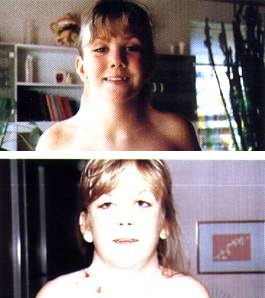維基百科 中的醫學內容
僅供參考 ,並
不能 視作專業意見。如需獲取醫療幫助或意見,請諮詢專業人士。詳見
醫學聲明 。
特納氏綜合症 (英語:Turner syndrome ,縮寫 :TS ),或稱45,X 45,X0 性腺發育不良 雌性 個體因X染色體 部分或完全缺失而引發的疾病[ 1] 蹼狀的頸部 低耳位 矮小 ,出生時即手腳水腫 等特徵。一般來說,特納氏綜合症患者沒有月經 、乳房 不發育而且不孕 ,且患有先天性心臟病 、糖尿病 以及甲狀腺功能低下症 的概率較正常人高。大部分的特納氏綜合症患者的智力水準正常,但許多患者的空間視覺能力 空間視覺能力 [ 2] [ 3]
特納氏綜合症並不是一種會遺傳 自父母親的疾病[ 4] [ 4] [ 5] 染色體異常 ,為X染色體部份或整條有缺失或改變而致。大部分人擁有46條染色體,但患有特納氏綜合症的患者卻僅有45條[ 6] 鑲嵌現象 [ 3] [ 7] 基因檢測 [ 8]
目前沒有任何已知的醫療方式可以治療特納氏綜合症,但卻多少對於緩和病徵有些幫助。舉例來說,在幼童發育時期注射生長激素 可以在之後的成人階段增加身高。雌激素替代療法 乳房 以及臀部 發育。在確定有哪些健康問題是由於特納氏綜合症造成後,才開始考慮需要怎樣的醫療照護來加以控制[ 9]
產婦生出罹患特納氏綜合症女童的概率大約介於1/2,000到1/5,000[ 10] [ 11] [ 4] [ 3] 亨利·特納 [ 12]
^ Turner Syndrome: Overview . Eunice Kennedy Shriver National Institute of Child Health and Human Development [2015-03-15 ] . (原始內容存檔 於2015-04-02). ^ What are the symptoms of Turner syndrome? . Eunice Kennedy Shriver National Institute of Child Health and Human Development. 2012-11-30 [2015-03-15 ] . (原始內容存檔 於2015-03-27). ^ 3.0 3.1 3.2 Sybert, Virginia P.; McCauley, Elizabeth. Turner's Syndrome . New England Journal of Medicine . 2004-09-16, 351 (12). ISSN 0028-4793 PMID 15371580 doi:10.1056/NEJMra030360 ^ 4.0 4.1 4.2 How many people are affected or at risk? . Eunice Kennedy Shriver National Institute of Child Health and Human Development. 2012-11-30 [2015-03-15 ] . (原始內容存檔 於2015-04-02). ^ Michael Cummings. Human Heredity: Principles and Issues . Cengage Learning. 2015: 161 [2016-06-28 ] . ISBN 9781305480674存檔 於2020-10-01). ^ Turner Syndrome: Condition Information . Eunice Kennedy Shriver National Institute of Child Health and Human Development. 2012-11-30 [2015-03-15 ] . (原始內容存檔 於2015-03-29). ^ What causes Turner syndrome? . Eunice Kennedy Shriver National Institute of Child Health and Human Development. 2012-11-30 [2015-03-15 ] . (原始內容存檔 於2015-04-02). ^ How do health care providers diagnose Turner syndrome? . Eunice Kennedy Shriver National Institute of Child Health and Human Development. 2012-11-30 [2015-03-15 ] . (原始內容存檔 於2015-04-02). ^ What are common treatments for Turner syndrome? . Eunice Kennedy Shriver National Institute of Child Health and Human Development. 2012-11-30 [2015-03-15 ] . (原始內容存檔 於2015-03-29). ^ Donaldson, M. D. C.; Gault, E. J.; Tan, K. W.; Dunger, D. B. Optimising management in Turner syndrome: from infancy to adult transfer . Archives of Disease in Childhood. 2006-06-01, 91 (6) [2022-11-01 ] . ISSN 0003-9888 PMC 2082783 PMID 16714725 doi:10.1136/adc.2003.035907 存檔 於2018-08-03) (英語) . ^ Marino, Bradley S.; Fine, Katie S. Blueprints Pediatrics . Lippincott Williams & Wilkins. 2013-01-22: 319. ISBN 978-1-4511-1604-5(英語) . ^ Kelly, Evelyn B. Encyclopedia of human genetics and disease . Santa Barbara, Calif.: Greenwood. 2013: 818 [2016-06-28 ] . ISBN 9780313387142存檔 於2021-03-09).

 . PMID 16714725. doi:10.1136/adc.2003.035907. (原始內容存檔於2018-08-03) (英語).
. PMID 16714725. doi:10.1136/adc.2003.035907. (原始內容存檔於2018-08-03) (英語).
